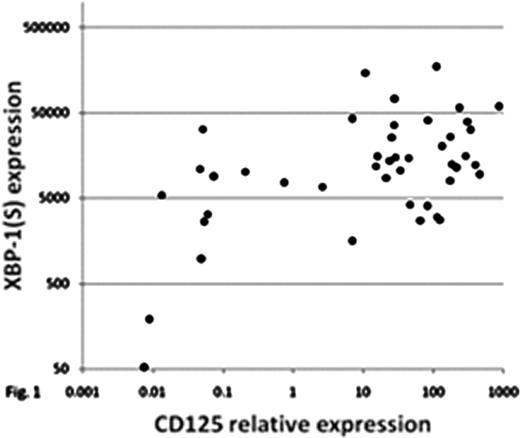Abstract
Abstract 616
Although marked heterogeneity in phenotypes of MM is known, classification of MM based on molecular expressions remains to be determined. During analysis of microarray data utilizing purified MM cells obtained from bortezomib-sensitive and resistant cases, we identified a 100-fold higher expression of CD125 in bortezomib-resistant MM cells. Because CD125, also known as interleukin-5 receptor alpha chain, is expressed on mature B cells undergoing class switch recombination, the existence of CD125 in MM cells may suggest that MM cells are at a less mature differentiation stage than plasma cells. We further tried to classify MM patients by analyzing correlations of CD125-expressions with other surface antigen expressions and endoplasmic reticulum stress (ER stress) response: the latter plays a crucial role in resistance to bortezomib. Correlation of CD125 expression with sensitivity to bortezomib therapy was also evaluated.
Bone marrow samples were obtained from MM patients under written informed consentaccording to Helsinki Declaration and processed for purification using CD138 immunomagnetic beads. Expressions of CD125 and spliced-XBP-1 (spliced-XBP-1 presence is a hallmark of activated ER stress response), were evaluated using real time PCR. Flowcytometry analysis was performed using gating CD38 bright population at SRL laboratory Inc. (Tokushima, Japan). Response to bortezomib was assessed according to the international myeloma working group criteria.
CD125 expression was found in MM cells at various levels. When it was compared to other surface antigen expressions, MM cells with expression of CD125 tend to express both CD20 and CD45 (p<0.05). Expression of CD125 also correlated with high expression levels of XBP-1s (Figure 1, p<0.01). The mean expression level of CD125 in bortezomib resistant cases was 6.17 fold greater than that in sensitive cases (110.6 versus 17.9, respectively, p<0.05). The mean expression level of XBP-1s in bortezomib-resistant cases was 2.3-fold greater than that in sensitive cases (p=0.06), which might suggest a role of ER stress in the regulation of sensitivity to bortezomib, while further detailed study should be required.
The present results suggest that CD125-expression in MM may represent a distinctive disease marker, which features immature phenotype, high ER stress response, and low sensitivity to bortezomib. High expression of XBP-1s in bortezomib-resistant cases suggests that the existence of ER stress response prior to bortezomib exposure may be responsible for poor response to bortezomib. Further analysis of CD125-positive MM cells is important for clarifying tumorigenesis at early stages of B-cell differentiation and possibly developing a new therapeutic strategy targeting ER stress.
No relevant conflicts of interest to declare.
Author notes
Asterisk with author names denotes non-ASH members.



This feature is available to Subscribers Only
Sign In or Create an Account Close Modal